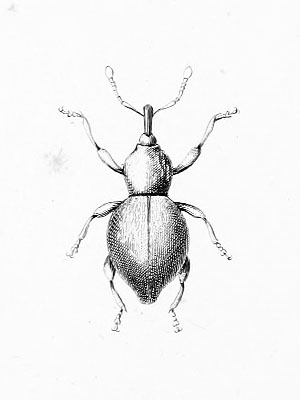Fringed Nesiobius Weevil (Nesiobius fimbriatus)
The Fringed Nesiobius Weevil was described in 1877; it was endemic to the island of Saint Helena; it inhabited the gumwood forests dominated by Gumwood (Commidendrum robustum (Roxb.) DC.) where the animals were found at the forest floor in decaying wood.:
“Thompson’s Wood is the only spot in which I observed this well-marked Nesiotes; and although the whole of my examples (22 in number) were obtained by shaking and sifting broken-up sticks and rubbish which were lying on the ground, nevertheless since the majority of the trees in that particular locality are gumwoods, I have little doubt that the N. fimbriatus belongs in reality to the gumwood fauna.” [1]
***
The species was not relocated during the latest field searches and is believed to be extinct. [2]
*********************
References:
[1] T. Vernon Wollaston: Coleoptera Sanctae-Helenae. London: John Van Voorst, Paternoster Row 1877
[2] Howard Mendel; Philip Ashmole; Myrtle Ashmole: Invertebrates of the Central Peaks and Peak Dale, St Helena. 2008
*********************
edited: 29.05.2021
Tag Archives: Nesiobius
Nesiobius breviusculus (Wollaston)
Short Nesiobius Weevil (Nesiobius breviusculus)
The Short Nesiobius Weevil was described in 1877, it was endemic to the island of Saint Helena, where it inhabited the Cabbage Tree forests, dominated by species like the She Cabbage (Lachanodes arborea(Roxb.) B. Nord.) and the He Cabbage (Melanodendron integrifolium (Roxb.) DC.) on the island’s Central Plateau.:
“It is a scarce species, so far as my own observations are concerned, but one which is nevertheless widely distributed along the whole central ridge, – my examples being from the vicinity of Diana’s Peak, as well as from High Peak and above West Lodge; and, unless it be in any way connected with the Aster gummiferus (or “Little Bastard Gummwood”) [Commidendrum robustum ssp. gummiferum (Roxb.) Cronk], which is far from impossible, I think that we must regard it as a member of the great cabbage-tree fauna.” [1]
***
The species was not found during the many recent field searches and is now considered extinct. [2]
*********************
References:
[1] T. Vernon Wollaston: Coleoptera Sanctae-Helenae. London: John Van Voorst, Paternoster Row 1877
[2] Howard Mendel; Philip Ashmole; Myrtle Ashmole: Invertebrates of the Central Peaks and Peak Dale, St Helena. 2008
*********************
edited: 29.05.2021
Nesiobius barbatus (Wollaston)
Bearded Nesiobius Weevil (Nesiobius barbatus)
The Bearded Nesiobius Weevil was described in the year 1877 by T. V. Wollaston on the basis of just three specimens, that he had collected by himself at a difficult to access slope at High Peak on the island of Saint Helena.:
“The only three examples which I have yet seen of this very rare Nesiotes were taken by myself on a precipitous and barely accessible slope behind High Peak and overlooking Peak Gut; and, in conjunction with the N. fimbriatus from Thompson’s Wood, it possesses a peculiar interest through the fact of its scape being powerfully barbed towards the inner apex with a cluster of coarse, elongated, squamiform bristles. This latter character, which is only faintly traceable in some of the other members of the group (and which, indeed, in the N. squamosus and simplex appears to be altogether absent), is so conspicuous in the barbatus and fimbriatus that, when taken in connexion with heir minute but very prominent eyes, the stronger and more erect setae of their entire surface, and their anteriorly much constricted prothorax, it is sufficient to place them in a different section of the genus ….” [1]
***
The species inhabited the forests dominated by the endemic Bastard Gumwood (Commidendrum rotundifolium(Roxb.) DC.), a tree species that is now completely extinct; the beetle was not fund during the recent field searches and is very likely extinct. [2]
***
The depiction below shows the Scaled Nesiobius Weevil (Nesiobius squamosus (Wollaston)); one of the still extant species of the genus.
*********************
References:
[1] T. Vernon Wollaston: Coleoptera Sanctae-Helenae. London: John Van Voorst, Paternoster Row 1877
[2] Howard Mendel; Philip Ashmole; Myrtle Ashmole: Invertebrates of the Central Peaks and Peak Dale, St Helena. 2008
*********************

Depiction from: ‚T. Vernon Wollaston: Coleoptera Sanctae-Helenae. London: John Van Voorst, Paternoster Row 1877‘
(public domain)
*********************
edited: 29.05.2021
